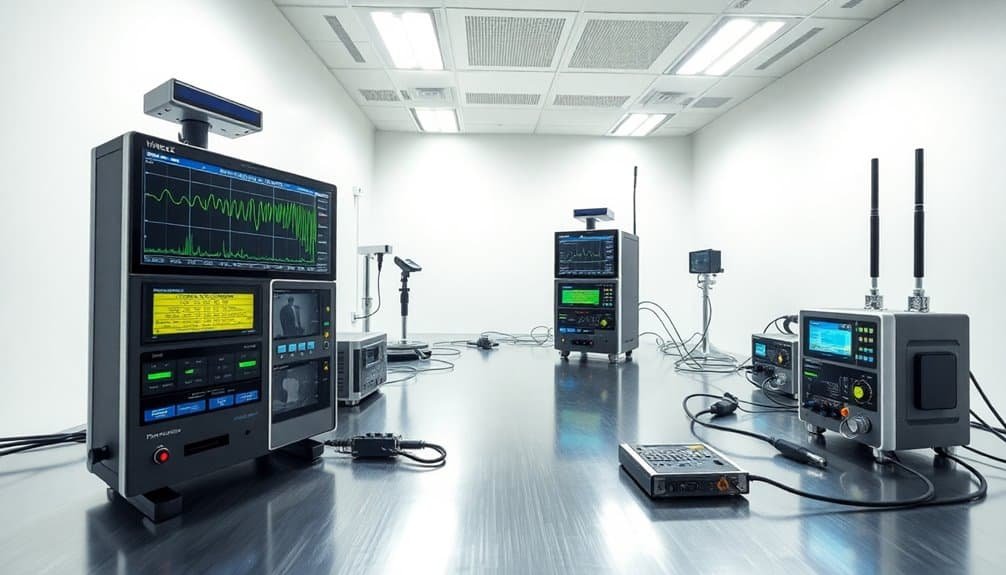Understanding International EMF Safety Standards
International EMF safety standards ensure exposure limits protect public health, with organizations like WHO and ICNIRP providing guidelines for frequencies from 100 kHz to 300 GHz. These standards address both thermal and non-thermal effects, and industries such as telecommunications and healthcare adhere to them.
Despite these guidelines, there are still research gaps regarding the long-term effects of EMF exposure. Gaining insight into regulatory frameworks can enhance your understanding of EMF safety.
Disclaimer: As an affiliate, I may collect a share of sales from the links on this page.
Key Organizations Involved in EMF Safety Standards

As you explore the landscape of EMF safety standards, it’s crucial to recognize the key organizations that shape these guidelines.
The World Health Organization (WHO) compiles global EMF standards, fostering harmonization among countries. The International Commission on Non-Ionizing Radiation Protection (ICNIRP) formulates widely accepted guidelines for exposure limits based on peer-reviewed literature. Occupational and general population exposures are considered separately to address differences in exposure duration and health effects.
The WHO’s EMF Project promotes scientific research to address knowledge gaps, involving 54 countries and 8 organizations to guarantee consistency. Regulatory frameworks like Model Legislation assist in implementing these standards.
Together, these organizations work collaboratively, aiming for public health protection against EMF exposure.
International EMF Safety Guidelines
To guarantee safety from electromagnetic fields (EMFs), international guidelines set clear exposure limits for both occupational and residential settings.
The ICNIRP guidelines focus on frequencies ranging from 100 kHz to 300 GHz, emphasizing the need to address both thermal and non-thermal effects.
The World Health Organization actively promotes the harmonization of these standards, aiming to alleviate public concern. Electromagnetic radiation has existed since the birth of the universe, underscoring the importance of these guidelines in managing contemporary exposure risks.
Updated periodically, these guidelines rely on research that evaluates biological effects and established health consequences.
Countries often base their legislation on these international guidelines, further enhancing global safety practices surrounding EMF exposure.
Compliance secures standardized protection worldwide, fostering public confidence.
EMF Safety Standards by Industry

Understanding EMF safety standards across different industries is essential for managing exposure risks. Telecommunications follow strict guidelines, often aligning with ICNIRP or IEEE standards for radiofrequency exposure. In energy and utilities, guidelines emphasize power line safety, focusing on low-level EMF effects. Healthcare must comply with specific standards for medical equipment and procedures to protect patients and staff, as health risks associated with EMF radiation can be significant. Aerospace and defense sectors reference IEEE standards, aligning with NATO guidelines. Consumer electronics face regulations ensuring products emit safe EMF levels. These industry-specific standards vary, emphasizing distinct compliance measures based on the nature of exposure and risks associated with each industry. Children may be more sensitive to RF radiation, necessitating heightened awareness and standards in industries that impact younger populations.
Health Effects and Research Gaps
Health effects related to electromagnetic fields (EMFs) represent a complex interplay of biological responses and potential hazards.
While low-frequency fields induce small currents with minimal effects, radiofrequency EMFs primarily cause tissue heating. Despite this, public concern persists regarding long-term effects from low-level exposure.
Current research gaps include inconsistent findings on symptoms, incomplete studies on radiofrequency heating, and limited epidemiological research on intermediate frequency fields. Investigating potential synergistic effects with other risk factors remains essential. Furthermore, understanding biological mechanisms and developing accurate exposure assessments can guide future research, ultimately informing guidelines and addressing public anxiety regarding EMF safety. Additionally, the potential health problems associated with 5G radiation exposure highlight the urgent need for comprehensive studies in this area.
Implementation and Regulation

While various international bodies work to establish a framework for electromagnetic field (EMF) safety, implementation and regulation vary greatly across countries.
The WHO compiles standards, while ICNIRP provides guidelines for exposure limits. In the EU, Directive 2013/35/EU mandates health and safety requirements for workers.
Countries outside the EU may adopt IEEE limits. Employers must mitigate risks, ensuring compliance with action plans when limits are exceeded.
Transparency is essential; employers must communicate their assessments.
Enforcement varies, with penalties for non-compliance differing among nations. Regular updates from regulatory bodies help maintain alignment with scientific advances on EMF safety.
Frequently Asked Questions
What Are Electromagnetic Fields (EMFS) and Their Common Sources?
Electromagnetic fields (EMFs) are physical fields produced by electric and magnetic sources. You encounter them daily from appliances, power lines, and wireless devices, along with natural sources like the Earth’s magnetic field and solar radiation.
How Can Individuals Protect Themselves From EMF Exposure?
In this digital jungle, you can shield yourself from EMF exposure by keeping devices at arm’s length, using speakerphones, and creating a sanctuary with specialized fabrics. Embrace smart habits for a healthier, safer living environment.
Are There Specific EMF Safety Standards for Mobile Devices?
Yes, there are specific EMF safety standards for mobile devices. These standards, set by organizations like ICNIRP and FCC, guarantee your devices comply with limits on exposure to protect you from potential health risks.
What Role Do Manufacturers Play in EMF Safety Compliance?
You guarantee EMF safety compliance by conducting thorough product testing, following relevant guidelines, and collaborating with regulatory bodies. Your adherence to safety standards protects consumers, maintains your reputation, and keeps you competitive in the market.
How Can I Find My Country’s EMF Exposure Regulations?
You can easily find your country’s EMF exposure regulations by checking government health websites, exploring WHO databases, or visiting dedicated resources like EH Trust. These sources provide up-to-date guidelines tailored to your location’s safety standards.
Conclusion
The world of EMF safety standards is complex. Despite extensive guidelines, many people still feel uneasy about EMF exposure.
Compliance exists, but knowledge gaps persist. This makes safety seem arbitrary.
Balancing health protection with technological advancement is delicate. Standards offer a framework, but understanding risks remains your responsibility.
What’s next in this evolving landscape?






